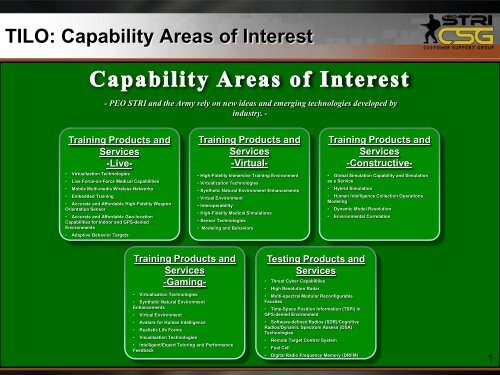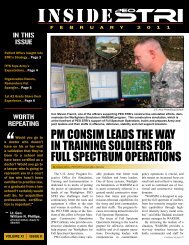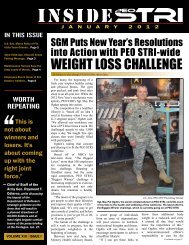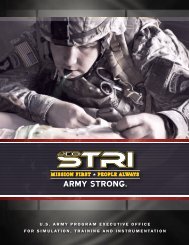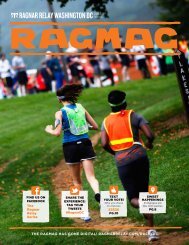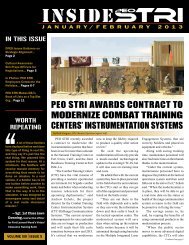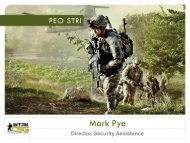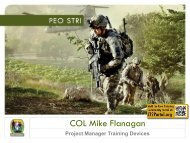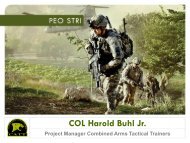TILO: Capability Areas of Interest - PEO STRI
TILO: Capability Areas of Interest - PEO STRI
TILO: Capability Areas of Interest - PEO STRI
Create successful ePaper yourself
Turn your PDF publications into a flip-book with our unique Google optimized e-Paper software.
<strong>TILO</strong>: <strong>Capability</strong> <strong>Areas</strong> <strong>of</strong> <strong>Interest</strong><br />
- <strong>PEO</strong> <strong>STRI</strong> and the Army rely on new ideas and emerging technologies developed by<br />
industry. -<br />
Training Products and<br />
Services<br />
-Live-<br />
• Virtualization Technologies<br />
• High-Fidelity Immersive Training Environment<br />
• Live Force-on-Force Medical Capabilities<br />
• Virtualization Technologies<br />
• Mobile Multi-media Wireless Networks<br />
• Synthetic Natural Environment Enhancements<br />
• Hybrid Simulation<br />
• Embedded Training <strong>PEO</strong> <strong>STRI</strong> is always interested in new ideas and emerging technologies developed by<br />
• Virtual Environment<br />
industry.<br />
• Accurate and Affordable High-Fidelity Weapon<br />
• Interoperability<br />
Orientation Sensor<br />
• Dynamic Model Resolution<br />
• High-Fidelity Medical Simulations<br />
• Accurate and Affordable Geo-location<br />
• Environmental Correlation<br />
Capabilities for Indoor and GPS-denied<br />
• Sensor Technologies<br />
Environments<br />
• Modeling and Behaviors<br />
• Adaptive Behavior Targets<br />
Training Products and<br />
Services<br />
-Virtual-<br />
Training Products and<br />
Services<br />
-Constructive-<br />
• Global Simulation <strong>Capability</strong> and Simulation<br />
as a Service<br />
• Human Intelligence Collection Operations<br />
Modeling<br />
Training Products and<br />
Services<br />
-Gaming-<br />
• Virtualization Technologies<br />
• Synthetic Natural Environment<br />
Enhancements<br />
• Virtual Environment<br />
• Avatars for Human Intelligence<br />
• Realistic Life Forms<br />
• Visualization Technologies<br />
• Intelligent/Expert Tutoring and Performance<br />
Feedback<br />
Testing Products and<br />
Services<br />
• Threat Cyber Capabilities<br />
• High Resolution Radar<br />
• Multi-spectral Modular Reconfigurable<br />
Facades<br />
• Time-Space Position Information (TSPI) in<br />
GPS-denied Environment<br />
• S<strong>of</strong>tware-defined Radios (SDR)/Cognitive<br />
Radios/Dynamic Spectrum Assess (DSA)<br />
Technologies<br />
• Remote Target Control System<br />
• Fuel Cell<br />
• Digital Radio Frequency Memory (DRFM)<br />
1
<strong>Capability</strong> <strong>Areas</strong> <strong>of</strong> <strong>Interest</strong><br />
Tr a i n i n g P r o d u c t s a n d S e r v i c e s – L i v e<br />
• Virtualization Technologies:<br />
Delivery <strong>of</strong> training and simulation services from centrally located simulation/processing hubs to provide better utilization and<br />
efficiency, and simplified support and maintenance.<br />
• Live Force-on-Force Medical Capabilities:<br />
Realistic casualty assessment algorithms based on weapon, ammunition, impact location, and use <strong>of</strong> body armor to replace the<br />
existing MILES casualty cards; <strong>Capability</strong> to perform Buddy/Self Aid via MILES devices; Allow combat medics to treat, administer aid<br />
to, and perform evacuations <strong>of</strong> “wounded” participants; Develop a medic’s field equipment pack to track usage during a training<br />
exercise; “Instrument” these capabilities.<br />
• Mobile Multimedia Wireless Networks:<br />
Highly scalable and mobile multimedia wireless networks using spectrum efficient and frequency agile s<strong>of</strong>tware defined radio<br />
technology with QoS. Capable <strong>of</strong> providing seamless movement across vast training/testing areas with low latency MANET, multihop<br />
and point to multipoint connectivity.<br />
• Embedded Training:<br />
Technologies for embedding training and simulation capabilities on tactical platforms and leveraging tactical platform hardware to<br />
perform dual functions to support both operational as well as training capabilities and mission rehearsal functions. Alignment with the<br />
VICTORY (Vehicular Integration for C4ISR/EW Interoperability) architecture and standard initiative for integrating electronics on Army<br />
ground vehicles and limiting SWaP-C impact to the tactical platform.<br />
• Accurate and Affordable High Fidelity Weapon Orientation Sensor:<br />
Provides high fidelity pointing vectors for weapons within their operational environments (i.e., ferrous metals); Accuracy: < .1<br />
degrees; Small form/fit, SWaP-C, Non-obtrusive to player/weapon; Simple calibration method.<br />
• Accurate and Affordable Geo -location Capabilities for Indoor and GPS -denied<br />
Environments:<br />
A high fidelity position/location system for real-time tracking soldiers in an indoor/urban or GPS-denied environment; Accuracy: 6-8<br />
inches/15-17 cm (T); 3-4 inches/10 cm (O); Low impacts to both soldier and infrastructure; Instrumentation System interoperability.<br />
• Adaptive Behavior Targets:<br />
Provision <strong>of</strong> an autonomous behavior target that portrays an asymmetric and reactive threat using sensor inputs. Enhanced target<br />
realism with realistic thermal/IR signatures, improved mobility (i.e. track-less) and bi-directional voice capabilities. Capable <strong>of</strong> intertarget<br />
communication/data sharing and reactions to events on other targets. Capable <strong>of</strong> supporting live fire with minimal failures/high<br />
RAM.<br />
2
<strong>Capability</strong> <strong>Areas</strong> <strong>of</strong> <strong>Interest</strong><br />
Tr a i n i n g P r o d u c t s a n d S e r v i c e s – Vi r t u a l<br />
• High Fidelity Immersive Training Environment:<br />
Believable, well-developed and economically feasible “interactive” computer-generated virtual humans and targets. Trainee<br />
interacts with, controls and commands virtual humans and targets in the ITE using natural language, motions and gestures.<br />
Realistic & cost effective locomotion <strong>of</strong> the trainee in the ITE. Effective implementation <strong>of</strong> VR/AR/MR technologies. Increase<br />
cognitive and emotional stressors.<br />
• Virtualization Technologies:<br />
Delivery <strong>of</strong> "distributed" training and simulation services from centrally located simulation/processing hubs to provide better<br />
utilization and efficiency, and simplified support and maintenance. Effective implementation <strong>of</strong> Cloud computing, virtualization<br />
and SOA concepts/technologies.<br />
• Synthetic Natural Environment Enhancements:<br />
Support air and ground mission rehearsal systems with rapid updates to existing terrain databases. Allow trainee to interact with<br />
physics-based models and receive appropriate feedback in the synthetic environment associated with route clearance/IED<br />
defeat and construction equipment training systems. Manipulate<strong>of</strong> physics-based virtual objects in a virtual environment.<br />
Common, robust weather and atmospheric simulation for real-time training systems in a DIS environment. Realistic life form<br />
representation in virtual simulations. Modeling and behaviors <strong>of</strong> soil/water characteristics.<br />
• Virtual Environment:<br />
Modeling <strong>of</strong> Obscurants/Illumination: Improve modeling <strong>of</strong> obscurants and illumination that impact sensors-behaviors and target<br />
engagement. Moving models with realistic thermal signatures.<br />
• Interoperability:<br />
Interoperability between virtual simulations, between virtual and constructive simulations, between virtual and live simulations.<br />
Common correlated terrains, fair fight engagements, SAF behaviors, etc.<br />
• High Fidelity Medical Simulation:<br />
Medical simulations whose interaction with the virtual world more realistically portrays the level <strong>of</strong> fidelity necessary to readily<br />
transfer the learning experience to actual patients; high fidelity medical simulations should match the vagaries <strong>of</strong> the<br />
individualistic nature <strong>of</strong> the human body and be easily User re-programmable to capture multiple nuances <strong>of</strong> a similar condition.<br />
High fidelity medical simulations to support combat medic, surgical support and ER team training.<br />
• Sensor Technologies:<br />
Sensor technologies to support immersive training environment: head tracking, eye tracking, weapons orientation, haptics,<br />
motion tracking, etc.<br />
• Modeling and Behaviors<br />
Provide physics-based modeling <strong>of</strong> ammunition effects and environmental damage. Provide realistic behaviors for virtual 3<br />
humans and crowds.
<strong>Capability</strong> <strong>Areas</strong> <strong>of</strong> <strong>Interest</strong><br />
Tr a i n i n g P r o d u c t s a n d S e r v i c e s – C o n s t r u c t i v e<br />
• Global Simulation <strong>Capability</strong> and Simulation as a Service:<br />
Delivery <strong>of</strong> training and simulation services from centrally located simulation/processing hubs to provide better utilization and<br />
efficiency, and simplified support and maintenance. Effective implementation <strong>of</strong> Cloud computing, virtualization and SOA<br />
concepts/technologies.<br />
• Hybrid Simulation:<br />
That allow running <strong>of</strong> federations either in non-time managed, best effort mode or time managed, reliable delivery mode or<br />
runtime combination <strong>of</strong> these two modes utilizing a single simulation data distribution mechanism.<br />
• Human Intelligence Collection Operations Modeling:<br />
Modeling and simulation <strong>of</strong> the complex Human Intelligence Process <strong>of</strong> collection and reporting. Simulation <strong>of</strong> human sources<br />
with unpredictable and sometimes unrealistic results. Modeling unpredictable human intelligence sources to produce more<br />
realistic results. Conveying <strong>of</strong> range <strong>of</strong> emotions on synthetic voices.<br />
• Dynamic Model Resolution:<br />
Ability to dynamically load and unload model components during runtime to vary the capabilities <strong>of</strong> entities.<br />
• Environment Correlation:<br />
Tools, technologies and processes to support quantification <strong>of</strong> correlation in environment databases and mechanisms to<br />
facilitate fixes and workaround.<br />
4
<strong>Capability</strong> <strong>Areas</strong> <strong>of</strong> <strong>Interest</strong><br />
Tr a i n i n g P r o d u c t s a n d S e r v i c e s – G a m i n g<br />
• Virtualization Technologies:<br />
Delivery <strong>of</strong> training and simulation services from centrally located simulation/processing hubs to provide better utilization and<br />
efficiency, and simplified support and maintenance. Effective implementation <strong>of</strong> Cloud computing, virtualization and SOA<br />
concepts/technologies.<br />
• Synthetic Natural Environment Enhancements:<br />
Support air and ground mission rehearsal systems with rapid updates to existing terrain databases. Allow trainee to interact with<br />
physics-based models and receive appropriate feedback in the synthetic environment associated with route clearance/IED defeat<br />
and construction equipment training systems.<br />
• Virtual Environment:<br />
Modeling <strong>of</strong> Obscurants/Illumination: Improve modeling <strong>of</strong> obscurants and illumination that impact sensors-behaviors and target<br />
engagement.<br />
• Avatars for Human Intelligence:<br />
Custom characters, animations, and detailed features to create realistic avatars for close human interaction.<br />
• Realistic Life Forms:<br />
Virtual humans with advanced behaviors, crowd behaviors, and animals.<br />
• Visualization Technologies:<br />
High fidelity/resolutions, 3D.<br />
• Intelligent/Expert Tutoring and Performance Feedback.<br />
5
<strong>Capability</strong> <strong>Areas</strong> <strong>of</strong> <strong>Interest</strong><br />
Te s t i n g P r o d u c t s a n d S e r v i c e s<br />
• Threat Cyber Capabilities:<br />
The capability to design, develop, and acquire threat cyber capabilities for threat Computer Network Operations (CNO), threat<br />
Computer Network Attack (CNA) and Computer Network Defense (CND) for the DoD and Services cyber test and evaluation;<br />
Remote command and control <strong>of</strong> multiple cyber <strong>of</strong>fensive platforms; Model and execute <strong>of</strong>fensive cyber activities to provide<br />
force multiplier effects for test and training events.<br />
• High Resolution Radar:<br />
The capability for radar processing and signature measurements for munitions, sub-munitions, and high altitude missile<br />
intercepts. Process large amounts <strong>of</strong> high resolution data. Capture and process highly detailed data on impact and dispersion.<br />
Determine final locations <strong>of</strong> all shrapnel to facilitate safe removal. Perform post mission 3D visualization for distribution and<br />
lethality assessment.<br />
• Multi-spectral Modular Reconfigurable Facades:<br />
The capability to provide facades <strong>of</strong> urban buildings that are modular, reconfigurable, transportable and that represent radio<br />
frequency, infrared and other spectrum characteristics.<br />
• Time-Space Position Information (TSPI) in GPS Denied Environment:<br />
High fidelity position/location system for real-time tracking in an indoor/urban or GPS-denied environment.<br />
• S<strong>of</strong>tware Defined Radios (SDR)/Cognitive Radios/Dynamic Spectrum Assess (DSA)<br />
Technologies:<br />
Affordable approach to support test/training applications; Configurable multi-spectrum SDR/Cognitive radios; spectrum efficient,<br />
frequency agile; small form/fit.<br />
• Remote Target Control System:<br />
Low cost sophisticated remote target control; Simultaneous remote control <strong>of</strong> mixed target platforms; remote control in a GPS<br />
denied environment.<br />
• Fuel Cell:<br />
Small, low cost, light weight, efficient fuel cells for dismounts.<br />
• Digital Radio Frequency Memory (DRFM):<br />
Physics/effects modeling <strong>of</strong> Digital Radio Freq Memory (DRFM) waveforms in M&S and injection for electronic attack<br />
simulators. 6
<strong>Capability</strong> <strong>Areas</strong> <strong>of</strong> <strong>Interest</strong><br />
E n g i n e e r i n g D i r e c t o r a t e<br />
Project/Program <strong>Capability</strong> Gap Domains Description<br />
•IEWTPT Human<br />
Intelligence (HUMINT)<br />
Control Cell (HCC)<br />
•VBS2<br />
•Dismounted Soldier<br />
Training Systems (DSTS)<br />
•Character Customization<br />
and Realistic Human-Avatar<br />
Interactions.<br />
•Avatar Speech Patterns in<br />
Co-Relation with Facial<br />
Gestures.<br />
•Unique and Varied 3D<br />
Character Modelization<br />
•Complex Avatar Skeletal<br />
Structure Allowing for<br />
Accurate Lip Synching and<br />
Independent Eye Movement.<br />
Virtual and<br />
Constructive<br />
Ability to produce custom characters, animations, and detailed<br />
features to help create realistic avatars for close human -<br />
emotion interactions. Automatic lip synching, eye movement,<br />
facial gestures co-related to computer generated speech.<br />
Unique 3D Character models with flexible bone structure<br />
allowing different height characters and different genders.<br />
Skeleton structure that allows for complex facial animations<br />
and/or detailed moving <strong>of</strong> the mouth. Including independent<br />
eye movement.<br />
•SE Core and recipients <strong>of</strong><br />
SE Core Geospatial data<br />
•Automation <strong>of</strong> GIS Vector<br />
and Imagery Alignment<br />
Live, Virtual and<br />
Constructive<br />
Currently an estimated 70-80% <strong>of</strong> all database development<br />
funds are used to manually align vector data to imagery (e.g.<br />
Correcting NGA data by moving roads and rivers to correct<br />
locations using imagery) Developing ways to automate parts<br />
or all <strong>of</strong> this would provide a significant cost savings to the<br />
Army. With the advent <strong>of</strong> GPU Shader technologies and<br />
enhanced compute power, the semi-automation <strong>of</strong> this arduous<br />
task is perhaps within reach. This SIBR effort would research<br />
the possibilities <strong>of</strong> using current technologies utilizing imagery<br />
analysis to find processes and tools to simplify an otherwise<br />
labor intensive effort.<br />
7
<strong>Capability</strong> <strong>Areas</strong> <strong>of</strong> <strong>Interest</strong><br />
E n g i n e e r i n g D i r e c t o r a t e<br />
Project/Program <strong>Capability</strong> Gap Domains Description<br />
•SE Core would develop<br />
the processes and<br />
procedures to produce the<br />
required common source<br />
lifeform models, and<br />
export them to each<br />
targeted IG runtime<br />
lifeform system. Other<br />
Army programs <strong>of</strong> record<br />
(i.e. CCTT, AVCATT,<br />
GCTT, GFT(VBS2) would<br />
integrate these runtime<br />
lifeform models into their<br />
system.<br />
•Common Lifeform Model<br />
Virtual,<br />
Constructive<br />
(stealths)<br />
Currently the visual models for lifeforms (Civilians, soldier,<br />
combatants, and animals) are modeled with a variety <strong>of</strong><br />
architectures with dependencies on the IG runtime lifeform<br />
interfaces (primarily COTS) that necessitate a unique model<br />
per IG runtime lifeform architecture. SE Core would need to<br />
model a lifeform library for each IG runtime lifeform system. SE<br />
Core needs a capability to model a visual lifeform model once<br />
and export it to a variety <strong>of</strong> virtual IG runtime lifeform systems.<br />
The SE Core Common Lifeform Model (CLM) shall represent a<br />
superset <strong>of</strong> all attribution, and data structures necessary to<br />
facilitate export to a variety <strong>of</strong> targeted IG runtime lifeform<br />
services. Market surveys shall analyze the market to identify<br />
targeted runtime lifeforms systems. Cost analysis shall be<br />
conducted such that proposed solutions shall consider lifeform<br />
modeling, motion capture, runtime model export, runtime IG<br />
model integration and runtime IG lifeform services integration<br />
costs. A CLM specification and a translation mapping to each<br />
targeted IG runtime lifeform systems shall be defined. Another<br />
consideration would include the development <strong>of</strong> a common IG<br />
runtime lifeform service which would provide a common<br />
representation <strong>of</strong> lifeform behaviors. Markets analysis <strong>of</strong><br />
capabilities and cost benefit analysis should be conducted.<br />
•JLCCTC, LVC-IA,<br />
OneSAF<br />
•Rapid Simulation Federation<br />
Data Alignment<br />
Live, Virtual,<br />
Constructive<br />
In any simulation federation such as JLCCTC there is a need<br />
to build individual simulation scenario and parametric<br />
databases in a fashion such that common data elements that<br />
are required to initialize more than one federation component<br />
are provided to these components consistently. For example<br />
the force database task organization shared by two federates<br />
within the JLCCTC federation should come from one<br />
authoritative data source and should be represented<br />
consistently as seen by these two components.<br />
8
<strong>Capability</strong> <strong>Areas</strong> <strong>of</strong> <strong>Interest</strong><br />
E n g i n e e r i n g D i r e c t o r a t e<br />
Project/Program <strong>Capability</strong> Gap Domains Description<br />
•JLCCTC, OneSAF<br />
•JLCCTC, OneSAF<br />
•Non-Traditional DCGS-A<br />
stimulation capability<br />
•Hybrid Simulation<br />
Architecture<br />
•JLCCTC •Virtual Test Environment (<br />
the ability to integrate and<br />
Test all or part <strong>of</strong> a Live,<br />
Virtual and Constructive<br />
Federation, across a wide<br />
geographic area, while<br />
providing real time audio and<br />
video collaboration).<br />
Constructive<br />
Constructive<br />
Live, Virtual,<br />
Constructive and<br />
Test<br />
For years the constructive training community has interfaced<br />
and simulated ASAS and now DCGS-A via a series USMTF<br />
text messages with fixed format and limited data content.<br />
Since DCGS-A has the ability to filter, store, search and<br />
analyze a wide variety <strong>of</strong> data sources the simulations<br />
community should not continue to operate within the bounds <strong>of</strong><br />
these fixed format, limited content messages. New and<br />
innovative stimulation products to ffed intel staff and analysts<br />
based on events and conditions in constructive simulations are<br />
needed.<br />
The JLCCTC program has a need to accommodate and<br />
facilitate interoperation <strong>of</strong> models/tools that primarily exist in a<br />
connected, time managed and mostly aggregate federations<br />
and models/tools that primarily operate in a connectionless,<br />
non time managed, mostly entity level federations within a<br />
single federation infrastructure. A hybrid approach that allows<br />
a single federation infrastructure to be configured to run in a<br />
variety <strong>of</strong> modes based on the scenario, training objective and<br />
model compositions in required.<br />
Because a <strong>PEO</strong>-<strong>STRI</strong> goal is to provide an integrated training<br />
solution, including Live, Virtual and Constructive (LVC)<br />
domains, the integration <strong>of</strong> GOTS and COTS hardware and<br />
s<strong>of</strong>tware has to be achieved between groups <strong>of</strong> disparate<br />
developers. In order to accomplish this, there exists a frequent<br />
need to test the interfaces by traveling to a common lab<br />
location. This testing may also occur within a single domain, or<br />
between 2 or more domains. Because <strong>of</strong> the geographically<br />
distributed nature <strong>of</strong> the contractor’s facilities and the material<br />
developers’ labs, a “Virtual Development Lab”, including an<br />
audio/video collaboration environment is needed. This 9<br />
capability would reduce the duplication <strong>of</strong> hardware between
<strong>Capability</strong> <strong>Areas</strong> <strong>of</strong> <strong>Interest</strong><br />
E n g i n e e r i n g D i r e c t o r a t e<br />
Project/Program <strong>Capability</strong> Gap Domains Description<br />
•WARSIM, OneSAF, SE<br />
CORE<br />
•Automated Feature<br />
Extraction from imagery and<br />
raster data<br />
Live, Virtual and<br />
Constructive<br />
Currently, we do not have the capability, as part <strong>of</strong> our terrain<br />
generation process, to combine different<br />
resolutions/types/sources <strong>of</strong> Imagery and Raster data (at<br />
different levels <strong>of</strong> resolution) and extract road, vegetation and<br />
building vector data. Current feature extraction processes are<br />
manual or highly dependent on user manipulation. Most<br />
specifically, what is needed is the Combination <strong>of</strong> different<br />
sources (i.e. Google Earth, Google Maps, NGA CIB, NGA<br />
CADRG etc) <strong>of</strong> raster maps and imagery data into a seamless<br />
unified source from which to automatically extract road<br />
networks, vegetation and Building features. Most specifically,<br />
the edges <strong>of</strong> these different raster and imagery sources should<br />
be automatically ‘stitched’ to provide a seamless source <strong>of</strong> data<br />
from which road network, Building, and vegetation data can be<br />
extracted. Extraction <strong>of</strong> attribution from the buildings and other<br />
features should be done with minimal user intervention to<br />
expedite the time it takes to generate this data. Finally, the<br />
extracted feature data should be populated with EDCS<br />
(WARSIM EDM) and VPF (NGA) data dictionary attribution to<br />
support our current terrain generation tools.<br />
•WARSIM, OneSAF<br />
•Enhanced Dynamic<br />
Weather/Terrain Effects<br />
Live, Virtual and<br />
Constructive<br />
Currently, weather does not affect the mobility <strong>of</strong> units in<br />
WARSIM. Most specifically, dynamic weather characteristics<br />
such as precipitation, do not affect route planning and related<br />
costs functions in WARSIM. At this point, mobility is only<br />
affected by static feature attribution in SNE features (the STGJ<br />
in the features used to calculate speed reduction factors) and<br />
the slope calculated with the terrain skin triangles. As a result,<br />
changes in weather do not affect the static terrain (triangles<br />
and/or features) and the mobility <strong>of</strong> units at runtime. We could<br />
take advantage <strong>of</strong> dynamic terrain technologies that would repoligonize<br />
the terrain skin <strong>of</strong> an area as a result <strong>of</strong> weather<br />
10<br />
events at runtime (events such as heavy precipitation, snow,
<strong>Capability</strong> <strong>Areas</strong> <strong>of</strong> <strong>Interest</strong><br />
E n g i n e e r i n g D i r e c t o r a t e<br />
Project/Program <strong>Capability</strong> Gap Domains Description<br />
•JLCCTC<br />
•Flexible, multi domain, three<br />
enclave architecture<br />
Constructive<br />
The current Cross Domain solution for the JLCCTC MRFfederation<br />
provides for the main ground simulation to exist only<br />
in the lowest (usually coalition releasable) enclave. However,<br />
many US Mission Command applications can only reside in a<br />
US Only SECRET enclave. Therefore, flexible two way<br />
communications are required between Mission Command<br />
adapter applications in a higher enclave and the main ground<br />
simulation in a lower enclave. An alternative would be to<br />
provide a CDS that enables two way communications between<br />
a simulation interface at a lower enclave communicating with a<br />
Mission Command application operating at a higher enclave.<br />
•JLCCTC, OneSAF<br />
•Networking challenge when<br />
interfacing simulations to<br />
multiple AFATDS<br />
applications using native<br />
AFATDS capability and a<br />
single ExCIS interface device<br />
Constructive<br />
IP addresses for simulated platforms typically go in the same<br />
class C network as the live FDC that they are assigned to. If<br />
there is only one live AFATDS in the architecture, ExCIS can<br />
be placed in that network. If there is more than one live<br />
AFATDS, ExCIS would sit in one <strong>of</strong> those networks or in its<br />
own separate class C. Since those platforms are simulated,<br />
their native AFATDS communications originate from the ExCIS<br />
machine, who assumes the IPs for all the simulated units, all in<br />
different class C networks. However, the live FDCs trying to<br />
stimulate their simulated subordinate platforms, will never be<br />
able to reach them since their respective routers will not try to<br />
go outside its own class C network. There are two main<br />
feasible solutions. One is to have an inject point at every real<br />
class C network, besides each live box or subnet (class C) <strong>of</strong><br />
live boxes, to send/receive messages directed for simulated<br />
platforms. This can be an additional ExCIS box (suboptimal –<br />
increases footprint) or another box or networking equipment<br />
that can take these IPs and send them to same network the<br />
ExCIS box is in. The other solution is to save <strong>of</strong>f the user's live<br />
11<br />
AFATDS database, load a simulation database that will have<br />
all simulated platforms point to the routable ExCIS IP, and


